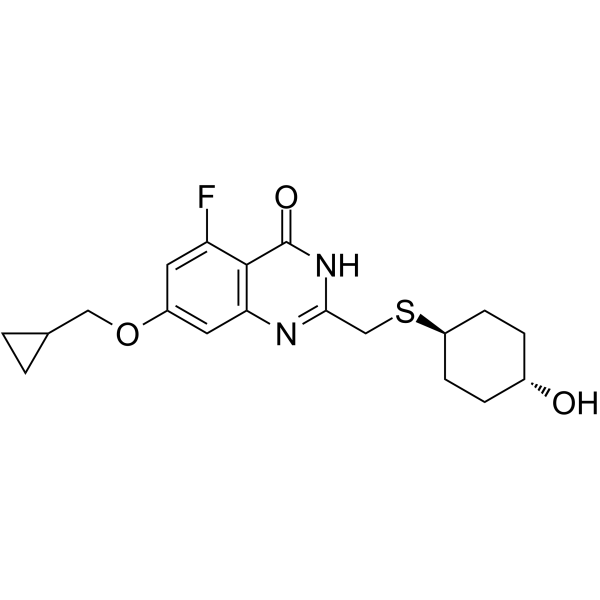Physicochemical Properties
| Molecular Formula | C19H23FN2O3S |
| Molecular Weight | 378.460927248001 |
| Exact Mass | 378.14 |
| Elemental Analysis | C, 60.30; H, 6.13; F, 5.02; N, 7.40; O, 12.68; S, 8.47 |
| CAS # | 2360851-29-0 |
| PubChem CID | 138696916 |
| Appearance | White to off-white solid powder |
| LogP | 2.8 |
| Hydrogen Bond Donor Count | 2 |
| Hydrogen Bond Acceptor Count | 6 |
| Rotatable Bond Count | 6 |
| Heavy Atom Count | 26 |
| Complexity | 549 |
| Defined Atom Stereocenter Count | 0 |
| InChi Key | NKZDEFKPZSLQRF-UHFFFAOYSA-N |
| InChi Code | InChI=1S/C19H23FN2O3S/c20-15-7-13(25-9-11-1-2-11)8-16-18(15)19(24)22-17(21-16)10-26-14-5-3-12(23)4-6-14/h7-8,11-12,14,23H,1-6,9-10H2,(H,21,22,24) |
| Chemical Name | 7-(cyclopropylmethoxy)-5-fluoro-2-[(4-hydroxycyclohexyl)sulfanylmethyl]-3H-quinazolin-4-one |
| Synonyms | RBN-012759; RBN012759; RBN 012759 |
| HS Tariff Code | 2934.99.9001 |
| Storage |
Powder-20°C 3 years 4°C 2 years In solvent -80°C 6 months -20°C 1 month Note: This product requires protection from light (avoid light exposure) during transportation and storage. |
| Shipping Condition | Room temperature (This product is stable at ambient temperature for a few days during ordinary shipping and time spent in Customs) |
Biological Activity
| Targets | PARP14 ( IC50 < 3 nM ); PARP4 ( IC50 = 10 μM ); PARP5a ( IC50 = 8 μM ); PARP5b ( IC50 = 10 μM ); PARP6 ( IC50 = 4 μM ); PARP7 ( IC50 = 4 μM ); PARP8 ( IC50 = 20 μM ); PARP10 ( IC50 = 1 μM ); PARP11 ( IC50 = 1 μM ); PARP12 ( IC50 = 5 μM ); PARP15 ( IC50 = 3 μM ); PARP16 ( IC50 = 6 μM ) |
| ln Vitro | RBN012759 is a potent inhibitor of human and mouse PARP14 with high selectivity for the PARP family that is moderately soluble, highly permeable, low efflux, and potent. Human primary macrophages treated with RBN012759 exhibit a dose-dependent decrease in the MAR/PAR signal corresponding to PARP14 self-MARylation and stabilization of PARP14 protein. When RBN012759 is administered to primary human macrophages, IL-4-driven M2-like gene expression decreases, indicating that PARP14 inhibition produces a less immunosuppressive phenotype. [2] |
| ln Vivo | RBN012759 exhibits a moderate oral bioavailability and clearance in mice. Mice can tolerate repeated doses of RBN012759 up to 500 mg/kg BID (75-fold coverage of the PARP14 mouse).[2] |
| References |
[1]. Cancer Res (2020) 80 (16_Supplement): 1038. [2]. AACR Annual Meeting 2020. |
Solubility Data
| Solubility (In Vitro) |
DMSO: 76~250 mg/mL (200.8~660.6 mM) Ethanol: 5 mg/mL |
| Solubility (In Vivo) |
Solubility in Formulation 1: ≥ 2.08 mg/mL (5.50 mM) (saturation unknown) in 10% DMSO + 90% (20% SBE-β-CD in Saline) (add these co-solvents sequentially from left to right, and one by one), clear solution. For example, if 1 mL of working solution is to be prepared, you can add 100 μL of 20.8 mg/mL clear DMSO stock solution to 900 μL of 20% SBE-β-CD physiological saline solution and mix evenly. Preparation of 20% SBE-β-CD in Saline (4°C,1 week): Dissolve 2 g SBE-β-CD in 10 mL saline to obtain a clear solution. Solubility in Formulation 2: ≥ 2.08 mg/mL (5.50 mM) (saturation unknown) in 10% DMSO + 90% Corn Oil (add these co-solvents sequentially from left to right, and one by one), clear solution. For example, if 1 mL of working solution is to be prepared, you can add 100 μL of 20.8 mg/mL clear DMSO stock solution to 900 μL of corn oil and mix evenly. (Please use freshly prepared in vivo formulations for optimal results.) |
| Preparing Stock Solutions | 1 mg | 5 mg | 10 mg | |
| 1 mM | 2.6423 mL | 13.2114 mL | 26.4229 mL | |
| 5 mM | 0.5285 mL | 2.6423 mL | 5.2846 mL | |
| 10 mM | 0.2642 mL | 1.3211 mL | 2.6423 mL |
